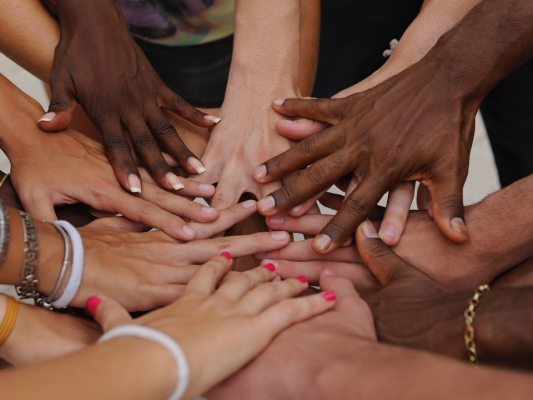Over the past couple of months, the CCI team has gathered for a series of retreats on Diversity, Equity and Inclusion, also known as DEI.
We kicked off the process by asking ourselves: “What would a DEI-focused culture look like at CCI?” And as we unpacked some new concepts and frameworks around these complex ideas, we realized that doing this work requires intentionality on all fronts.
We started one of our retreats with a powerful activity on intersectionality: a theory coined by Kimberle Crenshaw that considers how different identity categories (race, class, gender, etc) work together to inform one’s experience of the world. In order to help us understand this, we considered the parts of our identity that are most visible to others, and those parts which are less visible, and which we consider to be our “core” selves. In doing this activity, we were reminded how power and privilege play into the way we move through the world. On a deeper level, we gained an appreciation for how our own personal experiences have shaped us and impacted the way we show up for each other.
One of my biggest takeaways from this activity and from my understanding of intersectionality was that in order to dismantle systems of social inequality, we must consider our personal beliefs, our relationships with others, and how they feed into our unconscious biases.
Unconscious biases are attitudes and stereotypes that impact our actions and the way we perceive others. Conditioned especially through social systems and through mass media, we receive information from a young age about race, class, gender, and other identity categories that creates negative or harmful stereotypes. This conditioning is heavily reinforced in our everyday lives, and we often don’t realize it until we cause harm. For example, we read an excerpt from The Listening Leader: Creating the Conditions for Equitable School Transformation about a white elementary school teacher who had made a joke to her Black colleague which she thought to be a harmless comment, but which actually had racist implications. This highlights how our own experiences of privilege might create blind spots to others’ lack of privilege in certain areas, and we must cultivate our own awareness of this disparity in order to shift our biases.
Overall, this is more than language. If we silo our DEI work into simply being more mindful of what words we use, we ignore the ways that systemic oppression create barriers for marginalized communities to thrive. Unconscious biases about race in the health care system, for example, are amplified to the point that people’s lives are on the line. As my colleague Alexis wrote about Black mothers are about 3.4 times more likely to die from pregnancy-related causes. This is a glaring example of the ways in which racist perceptions of mothers of color impact their experiences within care systems. Embracing social change means being ready to address all facets of inequality and lean on those around us to push the work forward.
Addressing social inequality can be overwhelming and it’s easy to get lost in the many different ways that it manifests in our lives and in our communities. When we are intentional about setting expectations for our DEI work, we can ensure that we are working on the right things at the right time, and with the right people. Being a DEI-centered organization takes more than one person and one offsite retreat to implement change. I know that we now have some tools to make sure this work is sustained and uplifted for good.
Find this useful or interesting? We’re constantly sharing stuff like this. Sign up to receive our newsletter to stay in the loop.

